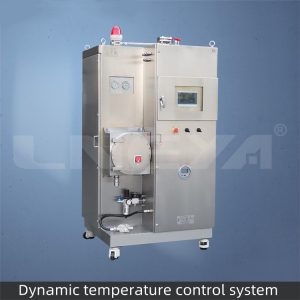What are the components that improve the performance of industrial chillers?
Industrial chillers are indispensable equipment in LNEYA production. With its normal operation, we will have better work efficiency and higher product quality. The refrigeration system of an industrial chiller is mainly composed of four core components: compressor, condenser, expansion valve and evaporator. On this basis, in order to improve the performance of industrial chillers, there are usually some auxiliary components.

(1) Compressors for industrial chillers:
It is the core of the entire chiller. Its quality is enough to affect the quality of a machine, and even the length of its lifespan. The compressor is the power source to ensure refrigeration. The compressor is used to increase the refrigeration pressure in the system, so that the refrigerant circulates in the refrigeration system to achieve the purpose of refrigeration. Common compressor types are open, semi-hermetic and fully-hermetic. Generally, the chiller with chilled water above 0°C adopts a fully hermetic compressor. If the chilled water is below 0°C, the low-temperature chiller uses a semi-hermetic compressor, while the open type is generally used in the refrigeration system with ammonia as the refrigerant.
(2) Condenser of industrial chiller:
It is the high temperature and high pressure Freon of the refrigeration system. After coming out of the compressor, it enters the condenser, releasing a lot of heat to the cooling medium, cooling and liquefying. There are three common types: water-cooled, air-cooled and evaporative. We mainly talk about water-cooled condensers. In a water-cooled condenser, the heat given off by the refrigerant is carried away by the cooling water. The cooling water can be flowed once or recycled. When using circulating water, cooling towers or cold pools are required. Water-cooled condensers have shell and tube, casing, immersion and other structural forms.
(3) Industrial chiller evaporator:
When the freon liquid in the refrigeration system enters the expansion valve and is sent to the evaporator, it belongs to the vaporization process. At this time, a large amount of heat needs to be absorbed, so that the temperature of the cooled medium is gradually lowered, so as to achieve the effect of cooling and cooling. According to the type of cooling medium, it is divided into two categories: cooling liquid (water) evaporator and cooling air evaporator.
(4) Industrial chiller expansion valve:
It is a throttling and pressure-reducing component that reduces the condensation pressure of the refrigerant to the evaporating pressure, so it is an essential component in the refrigeration system. It is called the four major components of the refrigeration system together with the compressor, the evaporator and the condenser.
Verwandte Empfehlungen
-
Was sind die Merkmale der Kältetechnik von Industriekühlern?
1746Besteht ein großer Temperaturunterschied zwischen Ein- und Auslasswasser, wird ein großer externer Tank zur Speicherung von Kaltwasser verwendet. In diesem Fall wird das Kühlwasser nicht direkt aus dem Kühler verwendet. Tief in die Außenseite des T...
Details anzeigen -
The Application of Cold Plate Freezer
1441The refrigeration system of cold plate freezer adopts secondary super-cooler technology with the rapid refrigeration and low limiting temperature. It uses imported brand name semi-hermetic piston compressors, semi-hermetic piston compound compress...
Details anzeigen -
Chemische Kühl- und Heizsysteme - Hersteller von dynamischen Temperaturregelungssystemen
1394In the pharmaceutical and chemical industries, cooling and heating system are widely used. As the developing of internet, many enterprises compete fiercely. The following will introduce the benefits of the LNEYA chemical cooling and heating system...
Details anzeigen -
Instructions for the use of temperature control equipment for isolation reactors
1335The reaction kettle is a commonly used reactor in pharmaceutical and chemical production. The temperature control equipment of the isolated reaction kettle is realized by controlling two doors, namely the heating water valve and the cooling water ...
Details anzeigen
 LNEYA Industriekühler Hersteller Lieferant
LNEYA Industriekühler Hersteller Lieferant












